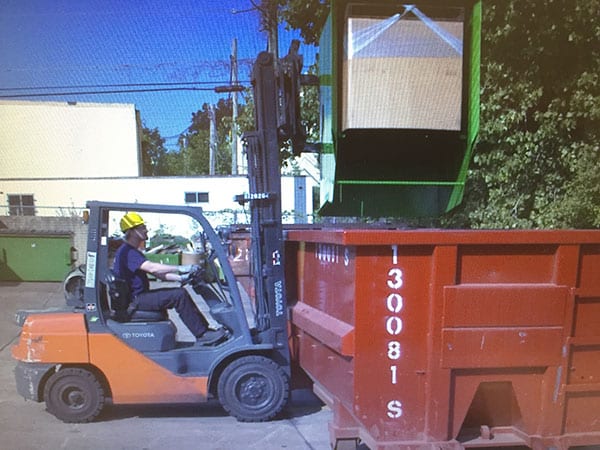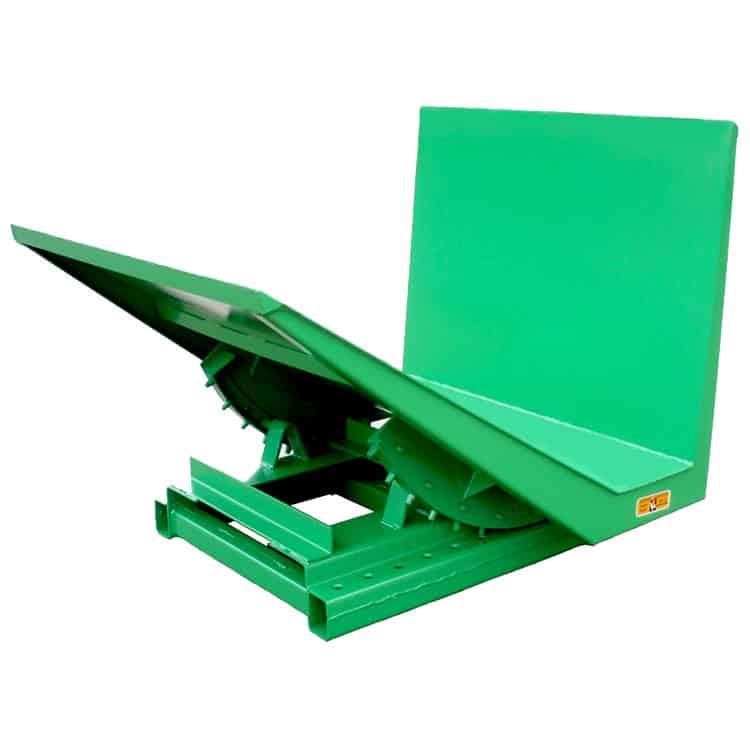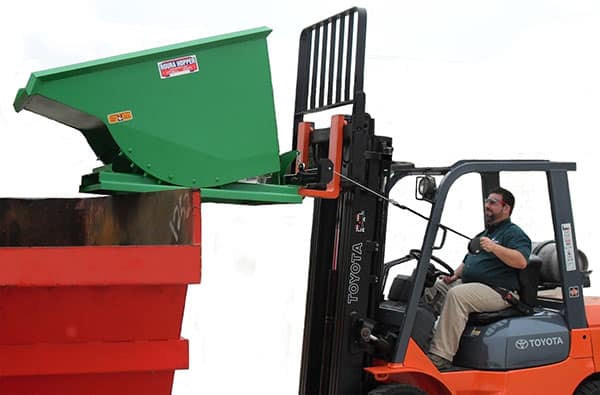Self-dumping hoppers are widely used and crucial for handling waste and transporting and storing materials, but they come in many sizes, designs, and capacities, making it challenging (and sometimes overwhelming) to find the right solution.
In this blog, we’ll break down the most important factors you should think about when selecting one for your specific application.
Type of Waste

The type of waste is arguably the most important factor, as it helps you determine weight/load capacity and the type of hopper you purchase (including the material it’s constructed from).
There are four primary types of waste you’re likely transporting/handling, including construction debris, organic waste, chemicals or other hazardous materials, and recyclables.
Construction waste is heavy and abrasive, so you’ll likely need a heavy-duty steel hopper with reinforced construction to ensure reliability and durability. Comparatively, there’s a lot of variety in organic waste. You might have hot or wet waste, like manure or dry waste, like grass clippings, and even acidic food waste, so you might want a stainless steel or plastic hopper because they’re easier to clean and sanitize and are resistant to corrosion. You may also want to consider a lid to prevent spillage.
With chemicals and hazardous materials, you really need corrosion resistance, so consider a stainless steel, galvanized steel, or aluminum model based on the corrosivity of the materials you’re handling. You can also get special linings to increase corrosion resistance and prevent chemical reactions.
Lastly, if you’re handling lightweight recyclables like paper, plastics, and textiles, you can go with aluminum or lighter gauge steel. Since these materials are lightweight and could easily fall out, you may also want to consider a lid to prevent spillage.
We’ll go into more detail on hopper material below.
Hopper Material

Steel is the most common material for self-dumping hoppers, but there are other materials you can choose, including stainless steel, galvanized steel, polyethylene, and aluminum. The type of material you choose will vary based on the materials you’re handling and the environment the hopper will be in.
Steel
Steel hoppers, especially carbon steel, are incredibly durable and strong and can handle rough treatment. They’re also extremely cost-effective, especially compared to stainless steel and aluminum. They’re primarily used for handling heavy materials like scrap metal, sand, and gravel.
Stainless Steel
Hoppers made from stainless steel resist corrosion and rust, so they’re often used in environments exposed to chemicals or moisture. Stainless steel is also easy to sanitize, so it’s used in applications requiring strict hygiene standards.
Galvanized Steel
Galvanized hoppers have a zinc coating on them to provide better rust resistance. They can be a good balance for people who need some corrosion resistance but don’t want to pay the extra cost for stainless steel.
Polyethylene/Plastic
Polyethylene is lightweight and quiet but very durable. It is typically used to handle sawdust and other fine and granular substances. Hoppers made from this material also have good corrosion resistance.
Aluminum
Although aluminum isn’t commonly used to produce hoppers, some manufacturers use this material because it’s lightweight, which makes the hoppers easier to move around with equipment. Aluminum hoppers are also rust-resistant. However, stainless steel will provide better corrosion resistance. Hoppers made from aluminum are also not as durable as steel, so they’re commonly used to handle and transport light to medium materials, such as agricultural waste.
Hopper Design

All self-dumping hoppers feature unique designs, and many of them can even be further customized to meet special application requirements.
Some specially designed hoppers include:
- Open-sided hoppers, which are long and narrow with (as you guessed by the name) open sides. This design makes the hopper ideal for handling wooden planks and other long and awkwardly shaped materials.
- Dewatering hoppers, which have finely perforated sides that help release excess liquid while trapping solids.
- Dross hoppers with wide perforations and heavy-duty double walls that can handle extremely hot materials.
- Skeleton hoppers, which feature three walls and one open side, so are ideal for handling sheet metal and other flat and wide materials.
Weight Capacity
Every hopper has a weight capacity limit. Exceeding this limit can cause tipping, material spillage, and even hopper deformation, so it’s critical that you pay attention to this limit and understand what capacity you need.
Look at the types of materials you’re handling now. What are the average and maximum weights of the materials you’re handling now? Are you planning on working with other materials in the future? If so, which ones and how much do they weigh?
It’s best to steer toward the heavier size (in terms of weight capacity) if you’re not sure. You can contact one of our experts today if you need help determining your weight capacity.
Available Space
Evaluate your space and consider the footprint of the hopper you plan to purchase. Hoppers need adequate clearance for safe operation, especially when emptying them. Because of this, you also need to consider the hopper’s height and swing radius to identify if there would be issues or obstructions during dumping.
Obviously, if you have limited space, you’ll want a smaller hopper. Some vertical designs can be helpful for small spaces, but again, you need to evaluate your clearance first.
Portability Needs
How often do you need to relocate your hopper? If the answer is “frequently,” choose an aluminum or polyethylene hopper unless you’re lifting extremely heavy materials. If you need both portability and a robust design, consider a heavy-duty hopper with wheels or casters. Wheels and casters also come in various materials based on the floor surface and overall environment.
Compatibility With Handling Equipment

Lastly, are you using the hopper with handling equipment, such as a forklift or crane? If so, you need a lift with specific features. Most of the time, forklift hoppers have pockets for the tines, while hoppers intended for use with a crane may have lifting eyes.
To ensure safe use, you should also look for a hopper with automatic latching systems or cable-operated release mechanisms.
Additionally, handling equipment will have a load capacity, so measure the weight of the hopper you’re purchasing and add the weight of the materials you’ll be handling to ensure you’re within that capacity.
Find Your Solution Today
Roura Material Handling was founded over a century ago and is the official pioneer of self-dumping hoppers. Since then, we’ve been engineering unique steel hoppers for various industries, including construction, mining, milling, food processing, and waste management.
If you’re still not sure what type of hopper you need, please contact our product specialists today. We can guide you through our inventory, offer recommendations, and even provide customization assistance.